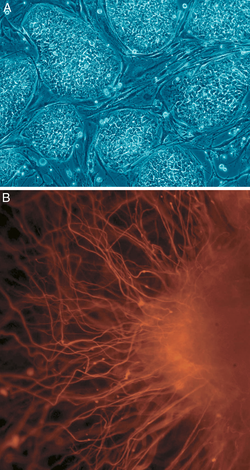Cell potency
Research on Caenorhabditis elegans suggests that multiple mechanisms including RNA regulation may play a role in maintaining totipotency at different stages of development in some species.[10] Work with zebrafish and mammals suggest a further interplay between miRNA and RNA-binding proteins (RBPs) in determining development differences.[12] This pathway entails erasure of CpG methylation (5mC) in primordial germ cells via the initial conversion of 5mC to 5-hydroxymethylcytosine (5hmC), a reaction driven by high levels of the ten-eleven dioxygenase enzymes TET-1 and'ability for many [things]')[14] refers to a stem cell that has the potential to differentiate into any of the three germ layers: endoderm (gut, lungs and liver), mesoderm (muscle, skeleton, blood vascular, urogenital, dermis), or ectoderm (nervous, sensory, epidermis), but not into extra-embryonic tissues like the placenta or yolk sac.[17] The ability to induce cells into a pluripotent state was initially pioneered in 2006 using mouse fibroblasts and four transcription factors, Oct4, Sox2, Klf4 and c-Myc;[18] this technique, called reprogramming, later earned Shinya Yamanaka and John Gurdon the Nobel Prize in Physiology or Medicine.Some of the similarities between ESCs and iPSCs include pluripotency, morphology, self-renewal ability, a trait that implies that they can divide and replicate indefinitely, and gene expression.iPSCs could potentially have the same therapeutic implications and applications as ESCs but without the controversial use of embryos in the process, a topic of great bioethical debate.[24] This result challenges the terminal nature of cellular differentiation and the integrity of lineage commitment; and implies that with the proper tools, all cells are totipotent and may form all kinds of tissue.Some of the possible medical and therapeutic uses for iPSCs derived from patients include their use in cell and tissue transplants without the risk of rejection that is commonly encountered.[27] Primed pluripotent stem cells from different species could be reset to naive state using a cocktail containing Klf4 and Sox2 or "super-Sox" − a chimeric transcription factor with enhanced capacity to dimerize with Oct4.[40] MSCs may prove to be a valuable source for stem cells from molars at 8–10 years of age, before adult dental calcification.



differentiatetotipotencypluripotencymultipotencyoligopotencyunipotencyPluripotentstem cellsblastocystplacentamorulatotipotentorganismSporeszygotesdifferentiationembryonicextraembryonic tissuezygoteendodermmesodermectodermcytotrophoblastsyncytiotrophoblastInner cell masstrophoblastsembryonic stem cellsCaenorhabditis elegansRNA regulationzebrafishRNA-binding proteinsgerm cellsgenomeepigeneticDNA demethylationbase excision repair5-hydroxymethylcytosine
TET-1
TET-2Pluripotency (biological compounds)Stem cellgerm layersInduced pluripotent stem cellssomatic celltranscription factorsfibroblastsreprogrammingShinya YamanakaJohn Gurdonmorphologygene expressionEuchromatinundifferentiatediPS cellscontroversial usetumorigenictransdifferentiationneuronscellular differentiationepiblastsX-inactivationFibroblast growth factorschimerasepiblast-derived stem cellssomitogenesisPLETHORA 1PLETHORA 2PLETHORA 3PLETHORA 5PLETHORA 7Progenitor cellslymphocytesmonocytesneutrophilsbrain cellsbone cellscord bloodbone marrowmesenchymal stem cellsthird molarcell typesendothelialPrecursor cellcell biologyhepatocytescholangiocytesMitalipov SBibcodeAnnual ReviewsAdult stem cellsCancer stem cellsEmbryonic stem cellCallusProgenitor cellEndothelial stem cellHematopoietic stem cellMesenchymal stem cellNeural stem cellStem cell therapyStem cell controversyStem cell lineStem cell lawsStem cell laws and policy in the United StatesEpigenetics in stem cell differentiation
